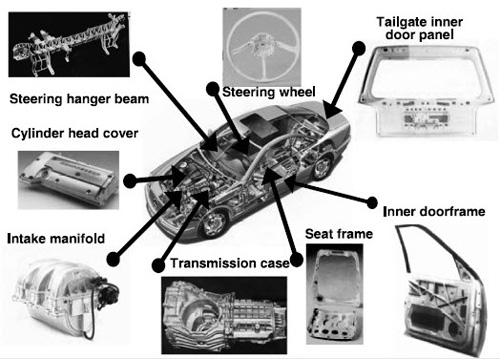Automotive Uses of Magnesium Alloys: Part One
A combination of light weight, high specific strength, and good castability makes magnesium alloys a promising engineering material for the automotive and aerospace industries. Mg-Al-based alloys, especially the AZ and AM series, combine good room-temperature strength and ductility with satisfying salt-spray corrosion resistance and excellent castability.
Vehicle weight reduction is one of the major means available to improve automotive fuel efficiency. High-strength steels, aluminum (Al), and polymers are already being used to reduce weight significantly, but substantial additional reductions could be achieved by greater use of low-density magnesium (Mg) and its alloys. Magnesium alloys are currently used in relatively small quantities for auto parts, generally limited to die castings, e.g., housings.
For passenger cars, the general rule is that about 86% of their total life time energy use from the time of production to the time of disuse or scraping is consumed by carrying their own weight and persons around.
Magnesium is an attractive material for automotive use, primarily because of its light weight - 36% lighter per unit volume than aluminum and 78% lighter than iron. When alloyed, Mg has the highest strength-to-weight ratio of all the structural metals.
Since the first oil crisis in the 1970s, there has been an economic and legislated move to make cars lighter in weight to improve fuel efficiency and reduce emissions. Cars have been made lighter by a combination of down-sizing, new designs (such as cab forward and front-wheel drive), and shifts to lighter materials. The most striking material shifts have been from iron to high-strength steel (HSS), and from iron and steel to aluminum and plastics. But magnesium offers even greater potential to reduce weight by displacing steel, and additional incremental savings by displacing aluminum and plastics from uses already taken over from iron and steel.
Magnesium is abundant. It is the eighth most common element; seawater, the main source of supply, contains 0.13% Mg, which represents a virtually unlimited supply. Magnesium is also recyclable, and instituting a recycling system would extend supplies and save energy. Major increases in automobile usage would eventually require U.S. production capacity expansion.
In traditional alloy development, experimental investigations are performed with many different alloy compositions. The selection criteria for multicomponent alloying elements and their compositions become diffuse in a traditional approach. Computational thermo chemistry based on the Calphad approach can provide a clear guideline for such selections and may help to avoid large-scale experiments with less promising alloys. Thus, it is a powerful tool to cut down on cost and time during development of magnesium alloys.
A comprehensive overview of the Calphad method is given by H.L. Lukas et al. More details on the ongoing development of a major thermodynamic database for magnesium alloys, currently comprising 20 components (Ag-Al-C-Ca-Ce-Cu-Fe-Gd-Li-MgMn-Nd-Ni-Sc-Si-Sn-Sr-Y-Zn-Zr) and 412 phases are given elsewhere.
The combination of light weight, high specific strength, and good castability makes magnesium alloys a promising engineering material for the automotive and aerospace industries. Mg-Al-based alloys, especially the AZ and AM series, combine good room-temperature strength and ductility with satisfying salt-spray corrosion resistance and excellent castability.
Sufficient creep resistance at elevated temperatures is also required by special automotive applications, such as engine blocks or power train components. For these elevated-temperature applications new magnesium alloys were developed on the basis of calcium and strontium additions or rare earth (RE).
A.A. Luo discussed the potential of these alloys and demonstrated promising results on the high-temperature strength for magnesium-based alloys with strontium and calcium, but called attention to possible castability problems like sticking and cracking. Additions of RE elements show similar advantages, but should be minimized considering then high costs.
These new alloys have already high temperature properties comparable to common aluminum alloys. A comparison of the performance of an oil pan made from the new magnesium MRI153M alloy and from aluminum A380 alloy revealed that the magnesium alloy performed similar and had the better damping properties.
Automotive applications require also good ductility for many components, especially energy absorbed in the case of an accident is a very crucial issue. One direction in the alloy and process development for wrought alloys is to optimize the energy absorption of the material. Nevertheless other components require preferentially higher strength than ductility. Thus alloy development follows various requirements and certain alloy groups can be identified to provide certain properties.
The majority of auto parts and components are made from a short list of common materials. The simplest approach is to look at material use by major system, and then correlate the material with function and/or manufacturing process. The three major systems or component groups are the body, the power train, and the chassis (Figure 1).

Figure 1: Applications of Mg Alloys in motor vehicles